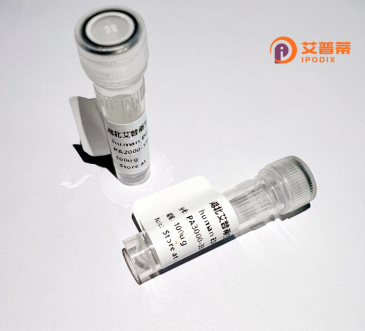
| 纯度 | >90%SDS-PAGE. |
| 种属 | Human |
| 靶点 | UBQLNL |
| Uniprot No | Q8IYU4 |
| 内毒素 | < 0.01EU/μg |
| 表达宿主 | E.coli |
| 表达区间 | 1-475 aa |
| 活性数据 | MWHAISRTSR MSQSGCPSGL LADKNISSSA TRVIVKTAGN QKDFMVADDI SVRQFKEMLL AHFQCQMDQL VLVFMGCLLK DHDTLSQRGI MDGHTIYLVI KSKQGSRSLA HSFRDLPTND PCHRDRNTKG NSSRVHQPTG MNQAPVELAH FVGSDAPKVH TQNLEVSHPE CKAQMLENPS IQRLLSNMEF MWQFISEHLD TQQLMQQNPE VSRLLLDNSE ILLQTLELAR NLAMIQEIMQ IQQPSQNLEY PLNPQPYLGL ETMPGGNNAL GQNYADINDQ MLNSMQDPFG GNPFTALLAG QVLEQVQSSP PPPPPSQEQQ DQLTQHPATR VIYNSSGGFS SNTSANDTLN KVNHTSKANT AMISTKGQSH ICATRQPAWI PALPSIELTQ QLQEEYKDAT VSLSSSRQTL KGDLQLSDEQ SSSQITGGMM QLLMNNPYLA AQIMLFTSMP QLSEQWRQQL PTFLQQTQIS DLLSA |
| 分子量 | 52.8 kDa |
| 蛋白标签 | His tag N-Terminus |
| 缓冲液 | PBS, pH7.4, containing 0.01% SKL, 1mM DTT, 5% Trehalose and Proclin300. |
| 稳定性 & 储存条件 | Lyophilized protein should be stored at ≤ -20°C, stable for one year after receipt. Reconstituted protein solution can be stored at 2-8°C for 2-7 days. Aliquots of reconstituted samples are stable at ≤ -20°C for 3 months. |
| 复溶 | Always centrifuge tubes before opening.Do not mix by vortex or pipetting. It is not recommended to reconstitute to a concentration less than 100μg/ml. Dissolve the lyophilized protein in distilled water. Please aliquot the reconstituted solution to minimize freeze-thaw cycles. |
以下是关于重组人UBQLN2蛋白的3篇代表性文献,信息简明概括:
1. **文献名称**:Mutations in UBQLN2 cause dominant X-linked juvenile and adult-onset ALS and ALS/dementia
**作者**:Deng, H. X. et al.
**摘要**:首次发现UBQLN2基因突变导致家族性ALS和ALS/痴呆症,提示其错误折叠蛋白清除功能受损可能与神经退行性变相关。
2. **文献名称**:Ubiquilin-2 (UBQLN2) binds actin filaments through its N-terminal actin-binding domain
**作者**:Kim, H. J. et al.
**摘要**:通过重组UBQLN2蛋白实验,揭示其N端结构域与肌动蛋白结合的能力,暗示其在细胞骨架调控中的作用。
3. **文献名称**:UBQLN2 mediates autophagy-independent protein aggregate clearance by the proteasome
**作者**:Hjerpe, R. et al.
**摘要**:证明UBQLN2通过泛素-蛋白酶体途径降解聚集蛋白,不依赖自噬,并解析其UBA结构域在此过程中的关键作用。
注:UBQLN2(Ubiquilin-2)研究主要集中于其在神经退行性疾病中的突变机制、蛋白质量控制功能及与其他细胞通路(如自噬、泛素化)的相互作用。如需更详细文献可补充具体研究领域。
Ubiquilin-like protein (UBQLNL), also known as UBQLN3. is a member of the ubiquilin protein family characterized by conserved ubiquitin-like (UBL) and ubiquitin-associated (UBA) domains. These domains enable interactions with the ubiquitin-proteasome system (UPS), playing critical roles in protein quality control by targeting misfolded or damaged proteins for degradation. Unlike other ubiquilin family members (e.g., UBQLN1/2), UBQLNL exhibits tissue-specific expression, predominantly in the testis, suggesting specialized functions in spermatogenesis or germ cell regulation.
Structurally, UBQLNL acts as a shuttle factor, linking polyubiquitinated substrates to proteasomal machinery via its UBL domain while stabilizing ubiquitinated clients through its UBA domain. It also interacts with autophagy receptors, highlighting a potential role in cross-regulating proteasomal and autophagic degradation pathways. Emerging studies implicate UBQLNL in cellular stress responses, including oxidative and endoplasmic reticulum stress, though its exact mechanistic contributions remain less defined compared to its paralogs.
Dysregulation of UBQLNL has been tentatively associated with male infertility and cancer progression, particularly in tissues with high proliferation rates. However, research on UBQLNL is still in early stages, with ongoing efforts to elucidate its physiological substrates, post-translational modifications, and regulatory networks. Its unique expression pattern and structural conservation position it as a key subject for understanding tissue-specific proteostasis and developing targeted therapies for related disorders.
×